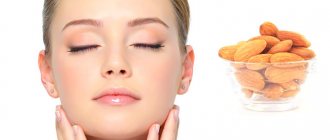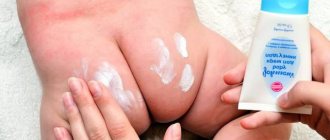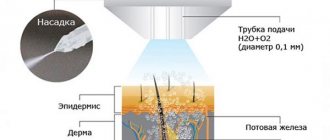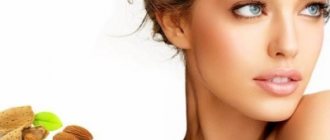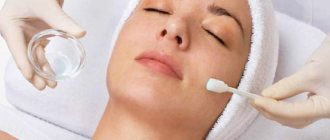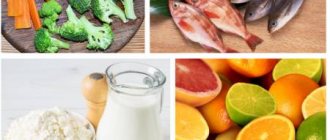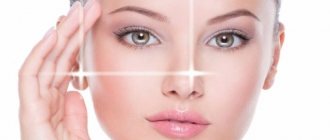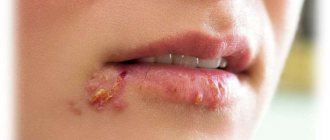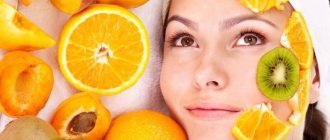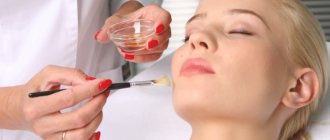- Indications
- Contraindications
- Kinds
- Distinctive features
- Principles of conducting
- Beneficial properties of hydroxyacetic acid
- Recovery period
- Side effects
- Course of procedures
- Use at home
- pros
- conclusions
To achieve aesthetic improvement of the skin, cosmetology uses procedures using diluted acids and biologically active substances - chemical peels, which differ in composition and method of action. One of the most gentle and effective methods is peeling with glycolic acid, which fully corrects imperfections and stimulates cellular metabolism.
Definition of the concept
Glycolic peeling is a common subtype of chemical peeling with superficial and medium effects, which has been used since the mid-20th century to exfoliate the upper layer of the epidermis, smooth out the relief and improve the quality of the skin. The procedure is based on the main element - concentrated glycolic (hydroxyacetic) acid, which belongs to the group of alpha hydroxy acids (fruit acids) and is naturally found in sugar cane, unripe beets and grapes. Glycolic acid is an active, safe component; it is transparent, hygroscopic, and odorless. The substance is used in complex products to eliminate skin defects and normalize tissue texture.
What it is
Glycolic peeling for the face is a type of exfoliation of the keratinized layers of the epidermis using a concentrated solution of glycolic acid. It allows you to activate the production of natural collagen, helps improve metabolic processes at the cellular level, cleanses and rejuvenates.
Thanks to this effect, the quality of the skin improves, tissue tone and elasticity increase. After completing the full course, the face looks refreshed and healthy.
Despite the gentle action of the main substance, it is always possible to achieve the desired result. The acid used during procedures is obtained exclusively from natural products. This could be beets, sugar cane, grapes.
On this topic
- Peeling
Peeling PRX-T33
- Olga Aleksandrovna Kalinina
- October 21, 2020
The effect of rejuvenation, improvement of external condition and healing is achieved due to the properties that the product has:
- rejuvenating - when penetrating into the deep layers of the dermis, the natural production of fibroblasts and collagen is activated, which helps to even out the relief and smooth out wrinkles;
- cleansing - due to their small mass, the molecules of the acidic substance have a deeper effect on the skin, as a result of which the connection between dead cells is disrupted;
- anti-inflammatory – peeling with glycolic acid is often used to treat acne and acne, prevents inflammation and suppresses foci of infection;
- lifting - effect - due to swelling after acid, the intercellular space is filled with cells, which makes it possible to increase tissue elasticity and level the surface of the epidermis;
- moisturizing – the skin after applying the drug receives sufficient hydration, which has a positive effect on the general condition.
It is worth noting that this type of peeling is divided into two main types.
Surface
Acid is used in concentrations of up to 40 percent. The pH level in this case will be from 2.4 to 4.4. Superficial glycolic peeling affects only the upper layers of the epidermis. After the session, the number of fine wrinkles is noticeably reduced, the complexion is evened out, and pigmented areas are lightened.
Experts recommend this type of procedure for young skin in order to correct minor defects or to combat increased oiliness.
Deep
In this case, the skin is exposed to a deeper effect. In this case, glycolic acid of increased concentration is used when the pH cannot be lower than 2.8.
Thanks to the effect on deep layers, all processes that occur in the dermis are activated. As a result, it is possible to obtain a more pronounced effect and eliminate visible age-related changes.
Indications for glycolic peeling
- Age-related skin changes: facial wrinkles, sagging, decreased elasticity in the face, neck, and décolleté.
- Photoaging: peeling, uneven relief, loss of elasticity.
- Oily, seborrheic skin: enlarged pores, acne, post-acne, comedones.
- Dryness, thinning of the skin.
- Hyperkeratosis is a thickening of the epidermis in the area of the stratum corneum.
- Hyperpigmentation.
- Superficial scars, stretch marks on the face and body.
- Prevention and treatment of molluscum contagiosum.
- Preparation for plastic surgery, mechanical and laser procedures.
Contraindications
- Pregnancy, lactation.
- Increased body temperature.
- Malignant, multiple benign neoplasms.
- Prolonged exposure to the sun and a fresh tan - less than two weeks.
- Increased photosensitivity of the skin.
- The active period of insolation is the summer and spring months.
- Viral and fungal diseases.
- Violations of the integrity of the skin: dermatitis, wounds, burns.
- Herpetic infection.
- Exacerbation of inflammatory processes and dermatoses.
- Autoimmune processes: scleroderma, systemic lupus erythematosus, rheumatoid arthritis.
- Severe damage to the cardiovascular system.
- Predisposition to keloid scars.
- Systemic and external use of retinoids and hormonal drugs.
- Individual intolerance to components.
Types of peeling by depth
- Superficial (acid concentration up to 40%, pH 2.5-4.5) - exfoliates the upper stratum corneum. Effective for young skin with minor lesions and for renewing and smoothing facial texture. For example, EYE & LIP CONTOUR PEELING, 28.5%.
- Superficial-medium, intermediate (acid concentration - 40-70%, pH - up to 2.8). It is used to activate proliferative mechanisms in deep skin areas (basal layer of the epidermis and dermis). For example, Anti Age Peel, 50%, ALGOMASK.
Types of peeling according to shape
- Free - easily penetrates deep into the skin, has maximum bioactivity and aggressive effects.
- Partially neutralized - widely used in cosmetology. It is highly effective and has a minimal irritant mechanism due to its combination with substances that reduce pH (amino acids, triethanolamine, collagen hydrolysate).
- Buffer and esterified - are practically not used in medicine, as they have little biochemical dynamism.
Distinctive features
- Glycolic acid has the smallest and shortest molecule among all alpha hydroxy acids, thanks to which it easily penetrates into the deep layers of the skin, has a pronounced exfoliating effect and saturates the tissues with oxygen.
- The depth of peeling penetration depends on the concentration and pH level (the lower the pH and the higher the concentration, the deeper the effect). For example, at pH-2.8 with a concentration of 35%, a more superficial effect is achieved than at pH-0.5 and a concentration of 70%.
- Before 30 years of age, peelings with a lower content of glycolic acid are prescribed, after 35 years of age - with a large amount of the active component to correct pronounced defects.
- To enhance the effect, glycolic peeling may include other fruit acids: lactic, citric, mandelic, as well as components that increase the protective functions of the skin (for example, chitosan).
- Glycolic peeling complements cosmetic procedures well: RF lifting, mesotherapy, biorevitalization, laser rejuvenation.
Important
During the procedure, it is necessary to constantly monitor the process, since glycolic acid penetrates the skin unevenly. And if the cosmetologist is distracted and does not apply a neutralizing solution in time to stop its action, a chemical burn is possible (not severe, but still unpleasant). And you certainly shouldn't do glycolic peel at home , even though solutions intended for professional use are often sold online.
Principles of glycolic peeling
- Consultation with a specialist and collection of anamnesis to identify contraindications, allergic reactions and possible course of antiviral therapy in case of frequent exacerbation of herpetic infection.
- Pre-peeling preparation for adaptation, cleansing and softening of the epidermis. Preparations with a small concentration of glycolic or other fruit acids (5-10% at pH-3-5) are used daily 1-2 times a day 7-14 days before the course method.
- Assessing the condition of the skin and conducting a test to exclude individual intolerance to the components.
- Makeup removal using a special milk with a concentration of glycolic acid up to 5% and degreasing (toning) of the treated area.
- Apply the composition of the selected concentration (starts from 15-30%) and pH level with a fan brush in one or several layers from the periphery to the center: forehead, temporal area, chin, area around the eyes. Exposure time is selected individually and ranges from 1 to 12 minutes.
- The use of air baths (fan) in case of mild burning and itching with constant monitoring of the process.
- Apply an alkaline neutralizer solution from the center to the periphery when the first signs of diffuse erythema appear for 2-3 minutes, followed by rinsing with water to normalize the water balance. For example, a neutralizing lotion is soothing.
- Use a restorative mask for 8-10 minutes.
- The use of products with moisturizing, nourishing and sun protection effects. For example, cream for age spots, SPF 45.
Beneficial properties of hydroxyacetic acid
- Rejuvenation - reducing wrinkles, smoothing skin microrelief, increasing density due to stimulation of fibroblasts and collagen synthesis.
- Cleansing - reducing adhesion in the stratum corneum, exfoliating “obsolete” cells and improving permeability.
- Moisturizing - binding, retaining water and normalizing hydrolipid balance.
- Restoring the secretion of the sebaceous glands.
- Whitening – reduction of age spots.
- Increased tissue elasticity (lifting effect) as a result of filling the intercellular space.
- Cell regeneration - anti-inflammatory, renewing and restorative effects.
- Normalization of metabolism, antioxidant and antitoxic mechanisms.
- Activation of internal and protective processes - stimulation of skin immunity.
The result of glycolic peeling. Photos before and after glycolic peeling
Immediately after the glycolic peeling procedure, a woman may feel a slight burning sensation of the skin, redness may remain for up to 24 hours . If the skin is very sensitive, prone to allergic reactions and irritations, then you may even experience swelling and crusts, like after a wound. After each glycolic peeling procedure, the cosmetologist recommends constantly moisturizing the skin with special products suitable for its type. Crusts and large flaking particles from the surface of the skin should not be removed under any circumstances , as this can lead to the formation of wounds and scars. The result of glycolic peeling is to normalize the functioning of the sebaceous glands on the skin, reduce oily skin, eliminate acne, blackheads, and reduce enlarged pores . Skin looks radiant, visibly younger and fresher . The elasticity and firmness of the skin increases . Due to the activation of fibroblasts in the skin and also the improvement of blood microcirculation in the epidermis, skin rejuvenation occurs naturally, with this effect retained for a long time.
Recovery period
- Do not use decorative cosmetics for 5-7 days.
- Use gentle cleansers, special regenerating, softening and soothing agents for 3-7 days to avoid forced peeling off of crusts (Bepanten, preparations with hyaluronic acid).
- Avoid aggressive drugs and procedures (scrubs, polishing) for 7-14 days.
- Do not visit the bathhouse, swimming pool, sauna or engage in heavy physical exercise for 7 days.
- Eliminate the influence of solarium, do not sunbathe for 14 days.
- Always use sunscreen with an SPF of 30 to 50.
Side effects
- Swelling is an expected reaction to a violation of the skin barrier within 2-3 days when using peeling.
- Redness is a natural reaction that lasts from a few hours to 3 days, depending on the concentration of glycolic acid in the products used.
- Peeling is the removal of superficial dead cells, which can last up to 7 days.
- Burns are undesirable phenomena that occur due to incorrect selection and exposure time of acid. When they occur, treatment is carried out with cold water and specialized anti-burn medications are applied.
- Hyperpigmentation and dry skin are response processes if recommendations are not followed before and after the procedure.
- An allergic reaction (rash, burning, redness, itching) occurs when the medical history is incorrectly collected. A preliminary test test is required in the area of the elbow or wrist in the form of peeling for 7-10 minutes to identify possible manifestations. When they occur, antihistamines are prescribed (for example, Zodak).
The effect of glycolic acid in Mene & Moy cosmetics
Glycolic (hydroxyethanoic) acid is a common component of many cosmetics. It has been well studied and has proven consistent effectiveness in many laboratory studies.
What is it and what is unique?
Hydroxyacetic acid has a burnt sugar odor and is found in plant foods such as grapes, sugar beets and cane. In cosmetics, it is used in two forms - natural and synthetic. Like other representatives of the AHA group, hydroxyethanoic acid activates the process of exfoliation of dead epidermis. However, unlike other representatives of the same spectrum of components, it has a low acidity level and low molecular weight. Due to these properties, penetration deep into the dermis occurs many times faster, and the chemical reaction occurs almost instantly. But even here, not everything is simple; the effectiveness and depth are directly affected by the pH level: the lower it is, the better for the active work of molecules.
Where is it used?
The comprehensive use of this ingredient in cosmetology is justified by its wide range of functions affecting different types of skin. It is used to care for problematic, oily skin and in anti-aging preparations. Professional peelings used in spa salons everywhere include the corresponding component. It is also often added to lightening serums and cosmetics for the treatment of acne and scars after it.
What will happen to the skin?
The speed of action of hydroxyacetic acid is noted not only by cosmetologists, but also by women who use it. Deep penetration under appropriate conditions ensures leveling of the terrain. Time is not calculated in months of use, but in days. Regeneration occurs more intensely when using professional, salon preparations with a high concentration of substances. Thus, cosmetics containing them have proven themselves as: • Narrowing pores; • Leveling relief and scar tissue; • Brightening tone.
The facts of a pronounced effect on aging and oily skin have been scientifically and experimentally proven. The high density of the integument and, as a consequence, the low rate of cellular regeneration require stimulation, which is artificially created by introducing glycol. The properties of AHA acid stabilize the outflow of skin secretions (subcutaneous sebum), and by stimulating cell renewal, it eliminates sallow color, changing the tone and evening out the surface.
About the impact
When chemical bonds are broken and the pH level decreases, peeling occurs. By getting rid of the dead stratum corneum, the body begins to form new, healthy cells. The skin becomes as after peeling – soft, pinkish and smooth. Due to the fact that the surface acquires a uniform relief, applying makeup is simplified. Obvious symptoms that the body cannot cope with dead cells on its own are dull complexion, local peeling, roughness, rough areas and wide pores.
If the renewal of the young dermis occurs in 28 days, then in the aged (40-45 years old) this cycle is 35-40 days, i.e. almost 1.5 times slower. Speaking of aging skin, the regeneration process can take from 2 to 3 months. The application of anti-aging serums or fluids allows you to smooth out wrinkles by influencing the body's natural processes from the inside out. Taking care of the renewal of the dermis, the chemical compound provokes the activation of natural protective reactions, or rather the production of collagen and hyaluron. And they, in turn, directly affect the reduction in the depth of wrinkles and their complete disappearance.
Limitation of use
Side effects and individual characteristics of each organism are not spared by products containing glycolic acid. In this regard, excessive caution will not harm those who:
• Has sensitive skin. The use of something in this case must be prescribed and, preferably, supervised by a specialist. Before independent use, a test application on the inside of the elbow must be carried out. As a result, incorrectly selected cosmetics with a high acid concentration can result in irritation, rosacea and prolonged peeling. It is better to increase the dosage of the active ingredient gradually, monitoring the reaction at each stage.
• Plans to go out in the sun. Despite its lightening properties, hydroxyethanoic acid increases sensitivity to ultraviolet rays. Using appropriate creams or lotions in the sun can result in a scattering of freckles or age spots. To protect against unwanted effects, it is recommended to use cosmetics with SPF before exposing yourself to the sun. Cosmetologists say that glycolic acid works better in winter when the level of solar activity is low.
• Suffering from acute acne. In this case, you should avoid products containing the above chemical compound altogether or use extreme caution. Rashes and suppuration indicate thinning and weakened protective functions of the integument. Incorrectly selected medications can provoke the spread of the problem.
The general recommendation for those who have no contraindications is to maintain hygiene, both cosmetic and household. Timely cleansing of the face should become a daily procedure. It is advisable to use disposable napkins as towels, and change pillowcases more often than bed linen.
Preparations with glycolic acid
This component is used in tonics, serums, gels for various purposes and degrees of effectiveness. At home, it is recommended to use cleansing tonics that support the renewal of the stratum corneum on a daily basis. For mechanical exfoliation, you should pay attention to scrubs and peels. They can be for both professional and home use. Caring masks with a cleansing and moisturizing effect contain hydroxyethanoic acid as a complementary element. As for daytime creams, it is better to give them preference if your skin is oily or aging.
In the mene Moy line there are the following products with glycolic acid: 1) Advanced Body Lotion 30% - Lotion with glycolic acid 150 ml 2) Advanced Cream 30% Glycolic Acid - Cream with glycolic acid 50 ml 3) Face & Body Cleanser 20% Glycolic Acid — Product with glycolic acid for cleansing the skin of the face and body 150 ml 4) Enhanced Cream 15% Glycolic Acid — Cream with glycolic acid 50 g 5) Facial Cleanser 4% — Product with glycolic acid for cleansing the skin of the face 150 ml 6) Glycolic Acid 10 % Masque - Cream mask with glycolic acid 10% 75 g 7) Glycolic Acid Gel 70% - Gel with glycolic acid 70% 59 ml Glycolic Acid Gel 30% - Gel with glycolic acid 30% 60 ml 9) Revitalizing Gel 15% - Facial gel with glycolic acid 50 ml 10) Revitalizing Lotion 15% - Lotion with glycolic acid 150 ml 11) Gel with 50% glycolic, 5% kojic and 5% phytic acid 59 ml 12) Face & Body Cleanser 15% - Product with glycolic acid to cleanse the skin of the face and body 59 ml 13) Face & Body Cleanser 20% - Product with glycolic acid to cleanse the skin of the face and body 59 ml
Glycolic Acid Gel 30% - Gel with glycolic acid 30% 60 ml 9) Revitalizing Gel 15% - Facial gel with glycolic acid 50 ml 10) Revitalizing Lotion 15% - Lotion with glycolic acid 150 ml 11) Gel with 50% glycolic, 5% kojic and 5% phytic acid 59 ml 12) Face & Body Cleanser 15% - Product with glycolic acid to cleanse the skin of the face and body 59 ml 13) Face & Body Cleanser 20% - Product with glycolic acid to cleanse the skin of the face and body 59 ml
14) Alpha beta complex gel
Summary
Article Name
Glycolic acid in Mene Moy cosmetics
Description
Glycolic acid promotes exfoliation and cell regeneration, improving skin color and texture. Added to 15 products in the Mene & Moy System line.
Author
Maria
Publisher Name
mene-moy.ru
Publisher Logo
Course of procedures
There are certain programs for glycolic peeling.
- Prevention of biological aging of the skin - 10 procedures once every 7-14 days. Maintenance course - 1-2 times a year.
- Prevention of photoaging - 5-10 procedures once every 7-10 days.
- Oily skin, hyperkeratosis, hyperpigmentation - 5-12 procedures once every 7-10 days.
- Correction of age-related changes, superficial scars - 3-5 procedures once every 1.5-2 months.
- Preparation for invasive methods of exposure - 5-10 procedures once every 10-14 days.
Home use
Glycolic acid for self-use is used in a concentration of up to 10% and a pH level of no more than 4 with a frequency of 4-6 procedures once every 7-14 days. When carrying out the technique, they are guided by standard instructions.
- Gentle cleansing and degreasing of the skin.
- Protection against peeling of lips and eyebrows with Vaseline.
- Apply the composition without pressure in one layer using a cotton pad or brush to the target areas: nose, chin, forehead, cheeks. Exposure time is 2-15 minutes.
- Use a slightly alkaline neutralizer if the burning sensation and redness intensifies, followed by rinsing with cold water.
- Using a soothing mask and moisturizer.
- Compliance with course post-procedure recommendations.
Making your own glycolic peeling from cane sugar ↑
If you don’t have the money to buy an expensive peeling, then you can prepare the composition yourself. For this you will need cane sugar and freshly squeezed lemon juice.
Pour one tablespoon of fine cane sugar into two tablespoons of warm water. Let the sugar dissolve and add lemon juice to the mixture. The consistency of the peeling composition should be similar to a paste.
Use the resulting sugar-lemon syrup immediately. To do this, use your fingertips to spread it evenly over your face and leave for 10 minutes. After the specified time, the peeling should be washed off with warm water. After the procedure, the skin of the face must be moisturized.
The number of glycolic peeling procedures is usually from 4 to 10. The interval between two visits to the cosmetologist’s office is 10-30 days, depending on the degree of damage to the skin. During the break between procedures, the doctor may prescribe the use of maintenance cosmetic products based on glycolic acid, which help consolidate the results already obtained.
Glycolic peeling is a fairly popular and inexpensive procedure. On average, one visit to a cosmetologist will cost 800-1200 rubles. But if you consider that there should be at least 4-5 such visits, then the amount automatically increases to 5000-6000 rubles. If you compare it with the prices for other types of chemical peels, then, of course, it’s cheaper, but if you do a glycolic peel at home, then the amount can generally be reduced by 10-15 times.
pros
- Versatility - can be used for all skin types at different ages.
- Less traumatic.
- Comfort and softness.
- Lack of toxicity and systemic effects on the body.
- Short recovery period.
- High efficiency - a pronounced result with a wide range of effects and a low percentage of side effects.
Minuses
- Course methodology.
- Availability of a rehabilitation period.
- Impossibility of correcting deep skin defects.
- Risk of undesirable consequences and individual intolerance.
